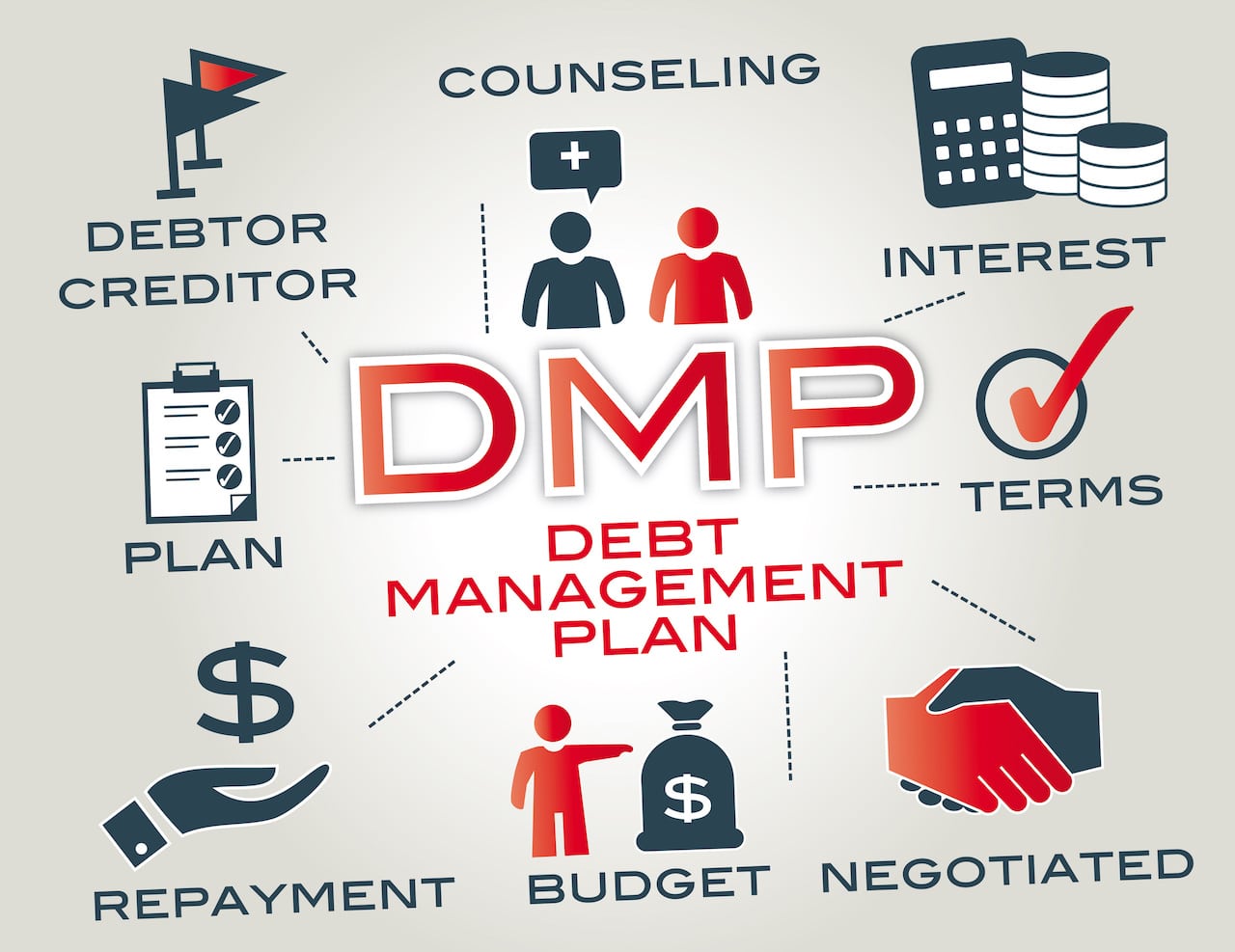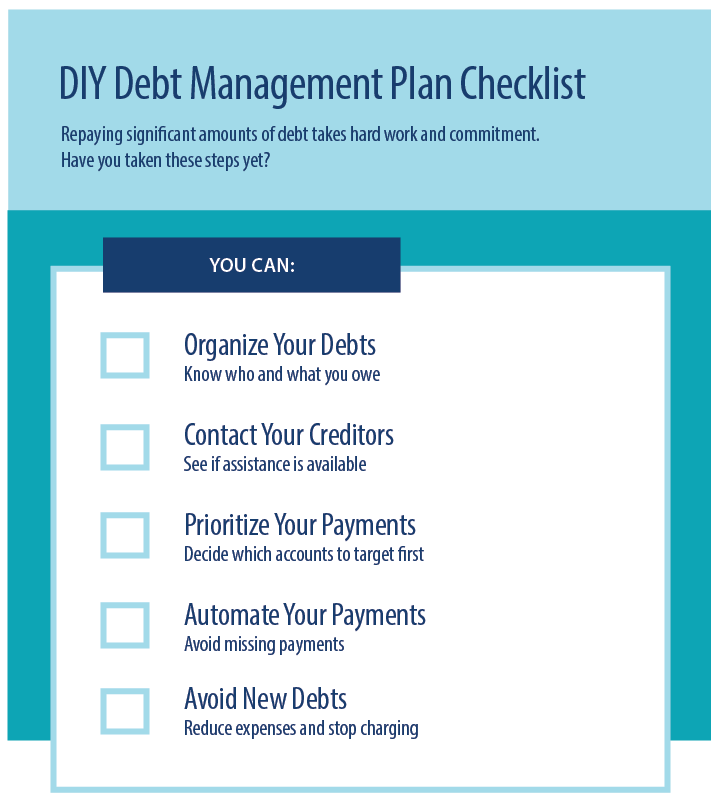Everything You Required to Find Out About Creating a Customized Debt Management Plan
In the world of individual money, creating a tailored financial obligation management plan is commonly the foundation of attaining economic security and peace of mind. As you navigate the intricacies of producing a tailored financial debt management plan, comprehending the ins and outs of each step is key to your financial success.
Evaluating Your Present Financial Debt Situation
One must first perform a complete evaluation of their present financial debt responsibilities prior to developing an effective financial obligation monitoring plan. Create a detailed checklist of each debt, consisting of the complete quantity owed, rate of interest rates, minimal regular monthly payments, and due dates.
After assembling this info, determine your complete debt-to-income proportion by separating your month-to-month financial obligation repayments by your regular monthly earnings. Understanding these facets of your economic scenario will direct you in developing a personalized financial debt monitoring strategy customized to your particular needs and goals.
Setting Financial Goals and Targets

When setting financial goals, it is very important to be specific, measurable, possible, appropriate, and time-bound (WISE) As an example, you might establish a goal to repay a certain amount of financial obligation within a details period, such as minimizing your charge card equilibrium by $5,000 in the following year - More Discussion Posted Here. By establishing clear targets like this, you can track your progression and stay motivated to accomplish your debt management goals
Furthermore, consider prioritizing your financial obligations based on variables such as rates of interest, superior equilibriums, and settlement terms. By concentrating on high-interest debts first, you can save cash in the long run and increase your trip toward monetary flexibility. Keep in mind, everyone's monetary situation is one-of-a-kind, so customize your targets and goals to fit your individual demands and situations.
Creating a Realistic Budget Plan
Crafting a well-defined budget plan is an essential action in reliable financial obligation management and financial planning. A practical budget acts as a roadmap for your financial health and wellness, aiding you track your earnings, costs, and financial debt repayments. To produce a sensible budget plan, begin by listing all your resources of income. This includes your salary, side hustle revenues, or any various other monetary inflows. Next off, catalog all your fixed expenditures such as lease or home mortgage, utilities, insurance, and funding payments. Variable expenditures like grocery stores, amusement, and transportation ought to likewise be included. Distinguish in between demands and wants to prioritize necessary expenses and identify areas where you can reduce back.
When establishing spending plan limitations, be honest with on your own regarding your spending practices and economic commitments. Assign a section of your earnings in the direction of repaying debt while ensuring you have some funds for cost savings and emergency situations. Routinely review and change your spending plan as needed to remain on track with your monetary goals and financial obligation payment plan. have a peek at this site By adhering to a sensible budget plan, you can successfully handle your debt and work towards an extra safe and secure monetary future.
Exploring Financial Debt Payment Strategies
After establishing a sensible budget plan, the following important action in effective financial obligation management is to explore various financial debt payment techniques. One common method is the snowball technique, where you focus on paying off the tiniest financial obligations initially while making minimum settlements on bigger financial debts. This approach can assist develop momentum as you see smaller financial debts being gotten rid of, supplying inspiration to take on larger ones.
One more method is the avalanche approach, which entails focusing on financial debts with the greatest rates of interest. By targeting high-interest debts initially, you can minimize the general quantity you pay in interest over time. This approach might be much more affordable over time, despite the fact that it might take longer to see specific financial debts totally paid off.
Debt consolidation is another choice where you combine numerous debts into a single finance with a reduced passion rate. This can streamline your repayment process and possibly minimize the overall rate of interest paid. Nevertheless, it's vital to meticulously think about the terms and costs related to consolidation to guarantee it's the right option for your economic situation.
Monitoring and Readjusting Your Strategy

Adjusting your plan might include reapportioning funds to take on high-interest financial obligations you can try these out first, working out with lenders for reduced rate of interest or better settlement terms, or discovering extra income sources to speed up debt settlement. As your economic circumstance evolves, your financial obligation management strategy must adapt appropriately to continue to be efficient. By remaining positive and versatile in tracking and adjusting your strategy, you can enhance your efforts towards paying off your debts efficiently and attaining your economic goals.
Verdict
In verdict, developing an individualized financial obligation management strategy entails assessing present financial debt, establishing economic objectives, developing a sensible budget plan, checking out repayment methods, and monitoring and adjusting the strategy as needed. By adhering to these steps, people can take control of their financial circumstance and work in the direction of ending up being debt-free. It is necessary to remain self-displined and dedicated to the plan in order to attain long-lasting financial stability.
One have to first perform an extensive assessment of their present debt commitments before formulating an efficient debt administration strategy.After developing a reasonable spending plan, the following vital step in efficient debt management is to explore various financial news obligation payment strategies - More Discussion Posted Here.To successfully handle your financial obligation, constant surveillance and change of your debt monitoring strategy are essential components for lasting economic stability.Adjusting your plan might entail reallocating funds to take on high-interest financial obligations initially, negotiating with creditors for lower passion rates or much better repayment terms, or exploring extra income resources to accelerate debt payment.In conclusion, creating an individualized debt monitoring strategy includes assessing present financial obligation, setting economic goals, creating a realistic budget, checking out settlement strategies, and surveillance and changing the strategy as needed